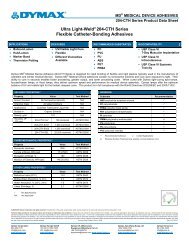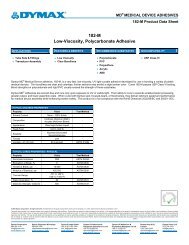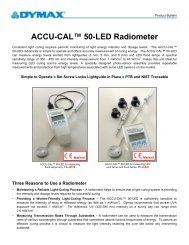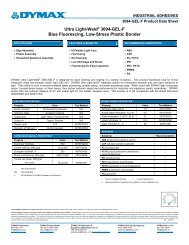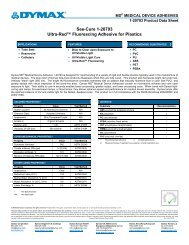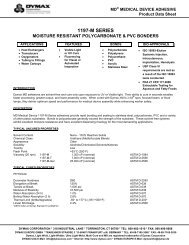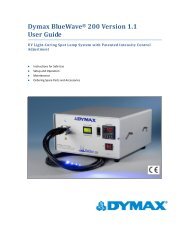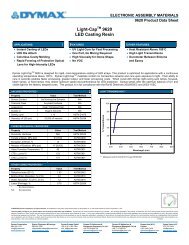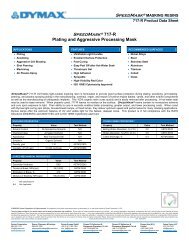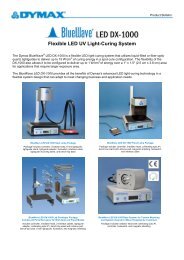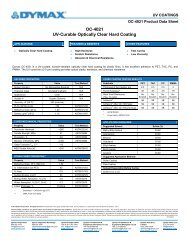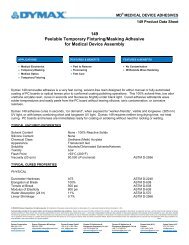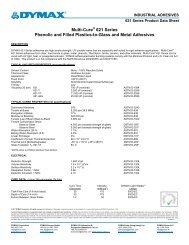Acrylic Acid-Free Adhesives for Motor Assembly - Dymax Corporation
Acrylic Acid-Free Adhesives for Motor Assembly - Dymax Corporation
Acrylic Acid-Free Adhesives for Motor Assembly - Dymax Corporation
You also want an ePaper? Increase the reach of your titles
YUMPU automatically turns print PDFs into web optimized ePapers that Google loves.
HistoryCold Bonding found general acceptance <strong>for</strong> automotive DC motor bonding in the 1980’s.<strong>Dymax</strong>’s Aerobic <strong>Acrylic</strong> <strong>Adhesives</strong> solved flammability and other safety concerns, which weresignificant issues <strong>for</strong> second-generation acrylics. Alternative acrylic adhesive technologiesoffered at that time included structural anaerobic adhesives and second-generation acrylics.Types Of <strong>Acrylic</strong> <strong>Adhesives</strong> Available For Magnet Bonding For DC <strong>Motor</strong>sCritical AdhesiveCharacteristicsAerobic <strong>Acrylic</strong> Anaerobic 2 nd Generation <strong>Acrylic</strong>Fixture Speed 20 - 40 seconds 1 - 5 minutes 40 - 90 secondsHigh Flash Point Yes No NoGap Cure 5 - 20 mils 3 - 5 mils 5 - 20 milsSurface Preparation Some Scrupulous Cleaning SomeOf these adhesive choices <strong>for</strong> magnet-to-can assembly, the Aerobic <strong>Acrylic</strong>’s superior fixturerate, combined with better gap cure and low flammability (200°C closed cup), won the day andthey became widely utilized <strong>for</strong> magnet-to-can bonding in DC motor assembly. This automatedassembly came to be called “cold bonding” by the industry.More types of cold bonding adhesives became available in the 1990s, as well as better heatcuring epoxy adhesives. Each of these types of magnet attachment has their respectiveadvantages and disadvantages.Heat-Cured Epoxy <strong>Assembly</strong> MethodSteps with nine workers:1. One or two workers bring parts to conveyor belt2. Two workers apply epoxy adhesive3. Four workers assemble magnets into housing, attach a stainless steel fixturing clamp, and themplace the clamped can onto the conveyor belt4. Parts are heated to 300°F <strong>for</strong> 30 minutes to cure the epoxy5. Two workers remove hot parts to cool down stack. Return fixtures to beginning of line-3-
Corrosion and <strong>Acrylic</strong> <strong>Adhesives</strong>All types of acrylic adhesives originally contained substantial quantities of either acrylic acidand/or methacrylic acid, which can be written collectively as (meth)acrylic acid. Recentlyhowever, patents have been issued <strong>for</strong> volatile acid free Advanced <strong>Acrylic</strong> <strong>Adhesives</strong>.(A)(B)How <strong>Acrylic</strong> <strong>Adhesives</strong> Lead To Internal CorrosionWhen a bead of activator-cured adhesive is put onto a surface and the mating part is put inplace, it is typical <strong>for</strong> adhesive at the edge of the joint to be exposed to oxygen. That edge,and any squeeze-out or fillet, can be the source of vaporization, possibly causing odor andhealth concerns in an open-architecture product, or corrosion in a closed cavity.Aerobic acrylic adhesives cure hard and dry between surfaces, leaving a film at the joint edgethat is exposed to air. Evolving from that film will be acrylic acid. Removing (meth)acrylic fromthe <strong>for</strong>mula eliminates both the potential concerns of workers and corrosion problems on thefinished part.Type(Meth)acrylic <strong>Acid</strong> Content<strong>Acrylic</strong> <strong>Acid</strong> <strong>Free</strong> Aerobic <strong>Adhesives</strong>Shown at left are commutators exposed touncured adhesive in a closed environment <strong>for</strong>500 hours at 200ºF . The clear, bright copperof the bottom commutator stands in sharpcontract to the one at top blackened withcorrosion.(A) The commutator at top was exposed to apopular “anaerobic” adhesive.(B) The commutator below was exposed to thenew (meth) acrylic acid free advancedaerobic acrylic adhesive.(Meth)acrylic <strong>Acid</strong>NoneAnaerobic <strong>Adhesives</strong> 4-6%Second Generation <strong>Acrylic</strong>s 5-30%Toughened <strong>Acrylic</strong>s 5-30%Methacrylic <strong>Adhesives</strong> 5-30%Aerobic <strong>Adhesives</strong> 2-5%-5-
Approved Source List Required: YesVolume: A Section .. Page: 311-7-
1.2 Scope of ApplicationThis standard applies specifically to Chrysler <strong>Corporation</strong> and its suppliers and subsuppliers<strong>for</strong> materials and parts <strong>for</strong> vehicles designed or engineered <strong>for</strong> North Americanproduction or export.ENVIRONMENAL, HEALTH, AND OCCUPATIONAL SAFETY REQUIREMENTS FORREGULATEDThere may, inSUBSTANCESaddition, be countryOR PROCESSESor region specificANDrequirementsPRODUCT RECYCLING<strong>for</strong> dismantling and/orREPORTINGhandling of end-of-lifeREQUIREMENTSvehicles. In these cases, specific accountability is as follows:1.0SpecificGENERALarea or country standards will be addressed by Chrysler InternationalOperations.1.1 Purpose of the StandardHomologation issues relative to obtaining certificates <strong>for</strong> the sales of vehicles areThisaddressedstandardby theprovides<strong>Corporation</strong>vehicleVehicleenvironmentalHomologationand occupationalstaff. Thissafetygrouprequirementswill provideasfoundseparatein Chrysler’sstandardsMaterial,to meet wholeProcessvehicleand Per<strong>for</strong>mancetype and/or partStandards.approval.It establishes,consistent and coordinated product recyclability guidelines and targets to support:Chrysler Parts and Service Division will develop a separate system to track recyclability,recycled content and regulated • Employees substances Health required by this standard, while utilizing thisstandard <strong>for</strong> all replacement • parts. Customers Health• Suppliers Employee Health1.3 Vehicle Paints • The EnvironmentFor Vehicle production body paints materials applied and by processes the car assembly plants, as well as those utilized onsupplier painted parts shall con<strong>for</strong>m to the requirements established by Paint and EnergyThis Management. standard was updated in August, 1997 to include policy direction or objectivesrelative to ISO 1402X and 1404X draft requirements addressing Life Cycle Assessment,as well as EU directives dated April, CS-9003, 1997 Change relative E, Page to vehicle 1 recyclability.4.1.2 Regulated SubstancesChrysler will also screen the regulated substances, listed in Table 6, be<strong>for</strong>e allowingthem to be used in new or carryover materials, processes or parts. These substancesare targeted <strong>for</strong> reduction or elimination, and – if they are present – Life CycleManagement analysis may be requested to evaluate the selected material and possiblealternatives.Table 6 Regulated SubstancesSubstanceCAS Number1,1 Dichloroethylene 000075-35-41,2 Dichloroethane 0000107-96-21,4 Dioxane 000123-91-12-Acetylaminofluorene 000053-96-32-Nitropropane 000079-46-93,3 Dichlorobenzidine 000091-94-13,3 Dichlorobenzidine Salts Multiple4-Dimethylaminpazobenzene 000060-11-74,4’ Methylene Dianiline (MDA) 000101-77-94,4’ Methylene Bis-2-Chloroaniline 000101-14-4Acetaldehyde 0000075-07-0Acetone 000067-64-1<strong>Acrylic</strong> <strong>Acid</strong> 000079-10-7Alpha-Naphthylamine 000134-32-7Aluminum (Fume or Dust) (1) 007429-90-5Antimony CompoundsMultipleArsenic 007429-90-5-8-
Federal & State RegulationsThe EPA defines <strong>Acrylic</strong> <strong>Acid</strong> as a “Hazardous Air Pollutant”. (See Section 112 of the ClearAir Act <strong>for</strong> a list of “regulated” substances.) Most states have begun requiring special licensesand fees <strong>for</strong> facilities contemplating the use of products containing acrylic acid. Staterequirements are available by contacting the relevant Department of Environmental Protection.Examples of state in<strong>for</strong>mation regarding acrylic acid:Clean Air Assistance ProgramMichigan Department of Environmental QualityP.O. Box 30457Lansing, MI 30457(800) 662-9278Clean Air ActSection 112Hazardous Air Pollutants (HAPs)See Table 3www.deq.state.mi.usIllinois EPADivision of Air Pollution ControlBox 19506Springfield, IL. 62794-9506Clean Air ActSection112(b)1TableCuring Chemistry Of The <strong>Acrylic</strong> <strong>Adhesives</strong> And Corrosion Formation<strong>Free</strong>-radical polymerization is common to all three types of acrylic adhesives – anaerobicstructural adhesives, SGAs and aerobic acrylic adhesives. Figure 1 shows that severalmechanisms can terminate the growing polymer chain. Two radicals can join to <strong>for</strong>m amolecular species or there can be an abstraction of hydrogen or a free-radical transfer.FIGURE 1FREE RADICAL POLYMERIZATION> C = C < + R . R C C . InitiationVinyl Compound <strong>Free</strong> Radical ⏐ ⏐⏐⏐⏐ ⏐ ⏐ ⏐ ⏐ ⏐R - C - C + > C = C R - C - C - C - C . etc.⏐ ⏐ ⏐ ⏐ ⏐ ⏐ Chain Extension⏐ ⏐R - (C - C) - C = C < Termination⏐ or ⏐ ⏐ ⏐⏐⏐ n-9-
R - (C - C)n - C - C - R⏐ ⏐ ⏐ ⏐All acrylics have their surface cures inhibited by oxygen. This inhibition responsible <strong>for</strong> thefamiliar “tacky” or even the wet surface frequently observed by users of acrylic adhesives.Laboratory tests comparing the lack of corrosion causing capability of the new adhesivescompared to the traditional types were conducted as follows with the results visible in Figure 2below.FIGURE 2Cold Bonding LimitationsA difficulty when using the cold bonding adhesive types was (1) that some manufacturers wereunable or unwilling to control gap tolerances, and (2) that imprecise application of adhesiveand activator, would lead to poor quality bonds.These “road blocks” have been largely removed because the strong impetus to achieve theassembly benefits offered by this technology has lead to the development of dispensing andassembly systems that provide the process and product reliability and quality required.Solvent <strong>Free</strong> Activators Posed A Dispensing ChallengeThe implementation of the U.S. Clean Air Act of 1993 presented a challenge to the dedicatedusers of the “cold bonding” systems. Though solvent-free activators had been shown toprovide as good or superior bonds, as the older solvent born activators, dispensing equipmentin use at the time was less effective at applying the correct amount, in the correct area. In anef<strong>for</strong>t to assure presence of the activator, instances of over activation occurred, which lead topoor bond strength. (Over activation was almost impossible to occur with the solvent bornactivators as ¾ of the amount deposited evaporated, leaving the desired thin film.) Since thattime, advances in dispensing and the concomitant monitoring and feedback systems, has metthe activator dispensing challenge.-10-
New Systems Offer Consistent Dispensing/Easier Automation For Cold BondingFor many years, the application of activators has been by inefficient rotary devices which flinguncontrolled amounts of activator onto the flux ring. This often caused an “over activation”condition causing a dramatically weakened bond line.New automated systems, called DADS <strong>for</strong> adhesive and activator applications have beendeveloped so that questions of consistency of application are eliminated. Systems areavailable <strong>for</strong> bonding various sizes and configurations of motors. These range from simplermodels <strong>for</strong> lower production situations to more automated models <strong>for</strong> high volume production.The pictures below show the two basic ways to dispense adhesive and activator:1. Separate Applicationa) Activator is sprayed inside on the motor canb) Adhesive is applied to the magnets of fixturec) Can is placed over magnet fixtured) Timing table actuated, <strong>for</strong> 30 secondse) Off loadActivatorDispensingApplyingAdhesive2. Spray-On-Beada) Adhesive applied to flat or curved surfaceb) Activator Sprayed on top of adhesivec) Parts mated within 10 seconds.d) Fixture <strong>for</strong> 30 secondse) OffloadAutomated<strong>Assembly</strong>Adhesive andActivatorDispensing-11-
*DADS is a trademark of the <strong>Dymax</strong> <strong>Corporation</strong>These systems are PLC controlled and can be monitored by an array of optional sensors tooptimize the application of activator and adhesive on the bond area of the flux ring andmagnet. The systems utilize highly efficient rotary air atomized needle valves. The systemsinclude all of the material supply equipment, fluid hoses and fittings to complete installation.They are available as off line dispensing stations, or in modular configurations <strong>for</strong> integrationinto automated production lines.Activator dispensers are designed to deposit a minimum amount of activator onto a substrateor the inside of a flux ring in the <strong>for</strong>m of a controlled mist. They may be programmed to applyactivator to the entire flux ring or to specific areas.Adhesive dispensers are designed to deposit a repeatable amount of adhesive onto a magnetin a bead type pattern to optimize the spreading and mixing action of the adhesive andactivator when the parts are fixtured together, while minimizing squeeze out of excessadhesive. Pressure sensors and flow meters insure that the appropriate amount of activator isapplied to the part monitor critical fluid pressure to insure that the appropriate amount ofadhesive is applied to the part.Other <strong>Motor</strong> <strong>Assembly</strong> Applications Using Multi-Cure ® Grades Of Aerobic <strong>Acrylic</strong><strong>Adhesives</strong>Multi-Cure CapabilityMulti-Cure adhesives are used through out the motor assembly industry. Multi-Cure combinesthe benefits of very fast UV curing (curing with Ultraviolet light) with activator (and/or heat)curing. The ability to achieve steel-bonding strengths to 3,500 psi whether cured by activator,UV light, or thermally, yields enhanced design options and process <strong>for</strong> improving productivity.commutator to shaftflange bondingsealingwire tackingmagnet bondingbearing mount-12-
-13-
Applications include:Armature wire strain reliefCoil terminationSealing seamFlange to can attachmentCommutator to shaftBearing mountCuring MechanismsUV cure onlyUV cure onlyUV cure onlyUV + activator cureActivator cureActivator cureMultiple Curing Options Eliminate Corrosion And Offer Additional Opportunities<strong>Adhesives</strong> can squeeze out from between metal or metal/ferrite surfaces. The adhesivebetween the two surfaces cures by action of the activator and the “squeeze out” may be curedby exposure to UV light. Where this happens and a fillet is UV cured, there is no outgassing orvapors to cause corrosion. Under high intensity light, curing occurs so rapidly, that the oxygeninhibition (discussed above) is overcome and no uncured residue is left.This use of Multi-Cure ® aerobic acrylic adhesives has allowed the UV cured fillet to serve as areplacement of a temporary fixture. This cured fillet serves as a tough plastic fixture holdingparts in place <strong>for</strong> the 30 to 60 seconds necessary <strong>for</strong> activator to fixture down inside the jointwhere the light can’t reach. This has worked successfully in can to flange attachmentapplications.The second use <strong>for</strong> Multi-Cure <strong>for</strong>mulations can occur when most of the adhesive used in ashallow potting application can be cured but a small amount may not “see” the light and remainuncured. New two part UV curing resins have recently been developed that are ideal <strong>for</strong>shallow potting where some of the resin may run under wires and not “see” the light to cure.Some Uses of Multi-Cure ® ResinsTab sealingWire tackingWire strain relief,unitizing, coilterminating-14-
Potting* Multi-Cure ® is a registered trademark of the <strong>Dymax</strong> <strong>Corporation</strong>-15-
SummaryNew technology in the dispensing and chemistry of aerobic acrylic adhesives now allowsconsistent, reliable bonding <strong>for</strong> DC motor assembly. <strong>Acrylic</strong> acid free technology providesregulatory compliant, high per<strong>for</strong>mance adhesives to enhance productivity <strong>for</strong> a wide range ofmotor assembly applications.DYMAX CORPORATION * 51 GREENWOODS ROAD * TORRINGTON, CT 06790 * TEL: 860-482-1010 * FAX: 860-496-0608DYMAX EUROPE GMBH * TRAKEHNER STRASSE 3 * D-60487 FRANKFURT a.M. GERMANY * TEL: 49-69-7165-3568 * FAX: 49-69-7165-3830<strong>Dymax</strong>, Light Weld, Light-Welder, Ultra Light-Weld and Multi-Cure are registered trademarks of <strong>Dymax</strong> <strong>Corporation</strong>DYMAX USA E-Mail: info@dymaxcorp.com * Internet: http:\\www.dymax.com-16-* DYMAX EUROPE E-Mail: dymaxinfo@dymax.de



